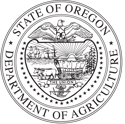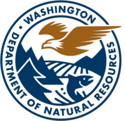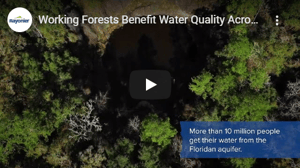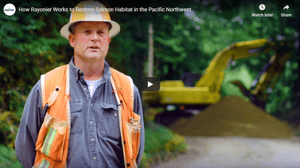.png?width=200&name=Rayonier_logo_122018_4_COLOR_TAGLINE%20(3).png)
Growing Healthy Forests in the Pacific Northwest
Click on each of the sections below to learn how herbicides help Rayonier and the forestry industry grow healthy forests.
![]()
Used to help newly-planted trees access sunlight and nutrients to grow into a healthy forest.

Used only one to two times in the lifecycle of a forest, approximately 40 years.

Selected specifically for the conditions of each site within each forest.
![]()
Safely handled, mixed, used, and disposed of according to their labels and the law.
![]()
Subject to thorough examination for compliance with all state and federal rules and regulations.
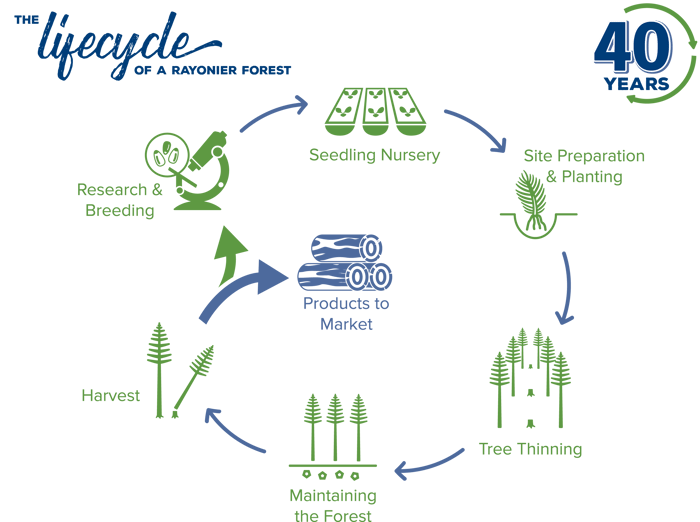
We communicate with neighbors
During the planning stages, our foresters identify adjacent landowners that we should talk to, and reach out to them via phone, face-to-face, and/or letters.
The type of property, the presence of people or animals, and the application method are some of the criteria that determines the notification needs. We seek to develop long-term relationships with our neighbors.
Depending on the location and type of application, we also post signs and/or close properties for public access.
We leave buffers
Before every application, our foresters identify and map buffers around streams, lakes, and other water bodies as required by law, and other sensitive areas. These buffers, which often range between 25 to 150 ft, are designed to minimize herbicide drift to areas other than the site intended for the application.
It's a State and Federal law plus it’s the right thing to do.
We don't spray under adverse weather
Before spraying, we check temperature, wind speed, relative humidity, and potential for rain. We don't spray under adverse weather conditions such as: excessive winds, steady rain (more than a steady drizzle), or when heavy downpours are expected within a short time of the application.
We work with the right people
We only work with contractors who are licensed applicators and work with local, on-the-ground, inspectors who we invite to our properties.
We minimize herbicide use
We select the herbicide to be used at each such site based on the needs of the site, the safety and efficacy of the herbicide. We follow the label instructions plus we minimize herbicide use to the lowest amount necessary to ensure our trees survive and thrive.
We use technology
Geographic information systems (GIS), combined with global positioning systems (GPS) technology help ensure that herbicides are applied precisely and only in the areas intended for the application. This information is kept and used for compliance monitoring.

Oregon Department of Agriculture
In Oregon, licensing and continuing education of applicators are required and administered by the Oregon Department of Agriculture (ODA). The Department of Agriculture is also responsible for enforcement of herbicide label requirements and other regulations.
Phone: (503) 986-4550
Website: https://www.oregon.gov/oda/Pages/default.aspx
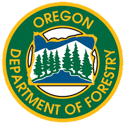
Oregon Department of Forestry
The Oregon Department of Forestry (ODF) enforces the Oregon Forest Practices Act (OFPA) rules and monitors herbicide applications, helping to assure their safe and proper use in Oregon’s forests. The OFPA further regulates the use of herbicides in forests in Oregon Administrative Rules (OAR) Chapter 629, Division 620, through a number of different rules, such as requirements to protect water sources, to prevent contamination of waters of the state. These requirements apply to registered drinking water sources as well as fish-bearing and non-fish streams. In addition to specific no-spray zones near streams, aerial spraying can only be done when weather conditions minimize spray drift from the target area.
Phone: (503) 945-7200
Website: https://www.oregon.gov/odf/Pages/index.aspx

Washington State Department of Agriculture
The Washington State Department of Agriculture (WSDA) has the legal authority to enforce both state and Federal pesticide law per Revised Code of Washington (RCW) 15.58 Washington Pesticide Control Act, and RCW 17.21 Washington Pesticide Application Act.
Phone: (360) 902-1800
Website: https://agr.wa.gov/
Washington Department of Natural Resources
A Washington Department of Natural Resources Practices Permit is required for aerial application of herbicides per Washington Administrative Code (WAC) 222-16-070.
Phone: (360) 902-1400
Website: https://www.dnr.wa.gov/
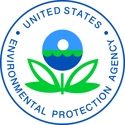
United States Environmental Protection Agency
No pesticide can be sold or used until it is approved by the Environmental Protection Agency (EPA).
Phone: (800) 424-8802
Website: https://www.epa.gov/
- Washington: in 2019, the Washington State legislature created a work group to review aerial application of herbicides in forestry. Rayonier supported both the legislation to establish the work group as well as the legislation codifying its results.
- Oregon: in 2020, Rayonier supported legislation in Oregon that restricted aerial application of herbicides in forestry near schools and inhabited dwellings, a standard practice for Rayonier. The legislation also increased buffers on watercourses, and established a modern notification system for the general public.
If you have questions about our operations
please call us. When giving us a call, please take note of the location, day, and time.
(360) 249-7004
If you have questions about misuse of herbicides, herbicide drift, worker protection standards in Oregon, please call ODA.
(503) 986-4635
If you have questions about misuse of herbicides, herbicide drift, worker protection standards in Washington, please call WSDA.
(844) 388-2020
- What is an herbicide? Is it the same as a pesticide?
Pesticides are used to grow healthy crops and protect from insects, diseases, and weeds. Herbicides, insecticides, and fungicides are all different types of pesticides. Each protects crops and forests from different pests. Herbicides improve growing conditions for young trees by reducing the density of brush and weeds. Insecticides and Fungicides, which are rarely used in northwest forests, protect from insects and diseases respectively.
- Why does Rayonier use herbicides?
Rayonier, and the forestry industry in general, periodically uses herbicides as part of site-specific forest management operations. We carefully evaluate each site, and use herbicides only where and when needed to control competing vegetation. The removal of invasive species, noxious weeds, and other competing vegetation helps the trees we plant survive and thrive.
- Why is it necessary to control competing vegetation?
In any forest, there is a limited amount of food, light and water (vital resources) for plants to use. When the baby trees we plant need to compete for vital resources with other vegetation, such as invasive species and noxious weeds, they may not be able to grow or even die. Just like you would weed a garden, Rayonier, and the forestry industry, uses herbicides to control competing vegetation to make sure trees have all the sunlight and nutrients they need to survive and thrive.
- Why can't weeds be pulled, mowed or cut?
If left unchecked, the weeds that grow in forests will become too deeply rooted and too large to remove by mowing, cutting or pulling. Pulling weeds will not always remove the roots, which allows the plant to regenerate and spread. Additionally, mowing weeds will spread their seeds and make the infestation worse.
- How long does the herbicide control competing vegetation?
Herbicides are used to control competing vegetation and limit competition for vital resources during the first year after new trees are planted. Typically, vegetation will re-emerge during the following years at which point the baby trees are strong enough to compete for vital resources to survive and thrive.
- Who reviews and approves the herbicides used in the United States?
The federal government regulates the use of all herbicides under the Federal Insecticide, Fungicide and Rodenticide Act (FIFRA). Under FIFRA, all herbicides and their active ingredients must be evaluated and registered by the United States Environmental Protection Agency (EPA) before they can be sold and used. The United States Environmental Protection Agency also consults with the United States Fish and Wildlife and National Marine Fisheries Services to evaluate potential impacts to fish and wildlife. The herbicide label is a legal document that specifies how much to use, when to use it, how to mix it, and more. The label must be followed by law.
- Are herbicides harmful to humans or wildlife?
Herbicides are safe when used according to the instructions specified in their labels. The effect of herbicides on humans or wildlife depends on the amount and time of the exposure. We follow forestry best management practices and product label instructions, and we apply rates that are typically far below what the label recommends to ensure exposure levels are below toxicological effect thresholds. Under these conditions, herbicides used by Rayonier and the forestry industry have very low toxicity levels, lower than most household cleaning solutions used everyday.
- How does Rayonier select and prescribe herbicides?
We select the herbicide to be used at each site based on the needs at the site and the safety and efficacy of the herbicide. When selecting and applying herbicides we rely on the product label and follow all label instructions, which is the law. We use the lowest amount of herbicide to achieve the result required at each site.
- How are herbicides used in forestry?
Typically, herbicides are applied to the:
• Entire area that is being treated
• Stems of specific trees
The most common application methods are:
• Aerial: applied by a helicopter
• Hand: applied by individuals using backpack tanks or spray bottles
- What are herbicides used for in forestry?
• Before planting: herbicides are applied prior to planting baby trees to control competing species and promote healthy growth. Application can be done aerially to the entire area being treated or by hand to individual tree stems.
• After planting: herbicides are applied after planting has been completed to promote healthy early growth, and ensure survival of baby trees. Application can be done aerially to the entire area being treated or by hand to individual tree stems.
- Who applies herbicides for Rayonier?
Herbicides are applied by professional applicators who must pass a state test and receive a license to legally apply pesticides. Applicators are required to attend continuing education classes to retain their license.
- What is drift and what does Rayonier do to manage it?
Spray drift is the movement of herbicide through the air during the application or soon after, particularly in windy conditions, to an area other than the site intended for the application. We take action to minimize spray drift to other areas: a) we select the appropriate equipment for the site of the application, b) we use drift control agents to increase the size of the droplets so they drop faster, and c) we leave buffers to minimize herbicide drift to areas other than the site intended for the application.
- What does Rayonier do to protect our water sources, the environment, wildlife and people?
We follow forestry best management practices and the law when applying herbicides so that we protect the public and the environment, including wildlife and aquatic habitat. We leave substantial buffers around sensitive sites such as houses, public roads, and waterways. Where we apply herbicides, we typically do it once or twice in the lifetime of a forest, which is about 40 years. This is less frequent than herbicides are typically used on lawns and gardens where they are often used monthly or annually.
- Who ensures that Rayonier does what it says it does?
We are dedicated to responsible management of all of our forests. Rayonier forests are certified under the Sustainable Forestry Initiative® (SFI) in the United States and under the Forest Stewardship Council® (FSC), and Programme for the Endorsement of Forest Certification (PEFC) in New Zealand. Our operations are also subject to compliance monitoring at the state level.
We are accountable to protect forests for current and future generations, our employees, and residents of the communities where we operate. This dedication to responsible management is backed by independent, third-party auditing of our forest management practices, including herbicide use, to ensure we meet both the letter and the spirit of our commitment to sustainable forestry.
We are Rayonier. We are More Than Trees.
Learn more about Rayonier here.
Rayonier is built on our ability to grow and manage a healthy, abundant renewable resource: trees. At every stage in the lifecycle of our trees, we take careful measures to ensure the long-term sustainability of our forests as well as the wildlife, soils, and water within them. We are committed to looking after the land for both current and future generations. Rayonier’s success depends on a continued commitment to the principles of environmental and economic sustainability – growing, maintaining and harvesting healthy forests that will enable us and the communities we live in to prosper well into the future.
We build trust through transparency. Go behind the scenes in these three videos and articles to learn more about what our employees do and how they do it. Click here to read all our stories.
